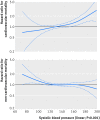Revisiting the association of blood pressure with mortality in oldest old people in China: community based, longitudinal prospective study
- PMID: 29871897
- PMCID: PMC5987177
- DOI: 10.1136/bmj.k2158
Revisiting the association of blood pressure with mortality in oldest old people in China: community based, longitudinal prospective study
Abstract
Objective: To examine the associations of blood pressure with all cause mortality and cause specific mortality at three years among oldest old people in China.
Design: Community based, longitudinal prospective study.
Setting: 2011 and 2014 waves of the Chinese Longitudinal Healthy Longevity Survey, conducted in 22 Chinese provinces.
Participants: 4658 oldest old individuals (mean age 92.1 years).
Main outcome measures: All cause mortality and cause specific mortality assessed at three year follow-up.
Results: 1997 deaths were recorded at three year follow-up. U shaped associations of mortality with systolic blood pressure, mean arterial pressure, and pulse pressure were identified; values of 143.5 mm Hg, 101 mm Hg, and 66 mm Hg conferred the minimum mortality risk, respectively. After adjustment for covariates, the U shaped association remained only for systolic blood pressure (minimum mortality risk at 129 mm Hg). Compared with a systolic blood pressure value of 129 mm Hg, risk of all cause mortality decreased for values lower than 107 mm Hg (from 1.47 (95% confidence interval 1.01 to 2.17) to 1.08 (1.01 to 1.17)), and increased for values greater than 154 mm Hg (from 1.08 (1.01 to 1.17) to 1.27 (1.02 to 1.58)). In the cause specific analysis, compared with a middle range of systolic blood pressure (107-154 mm Hg), higher values (>154 mm Hg) were associated with a higher risk of cardiovascular mortality (adjusted hazard ratio 1.51 (95% confidence interval 1.12 to 2.02)); lower values (<107 mm Hg) were associated with a higher risk of non-cardiovascular mortality (1.58 (1.26 to 1.98)). The U shaped associations remained in sensitivity and subgroup analyses.
Conclusions: This study indicates a U shaped association between systolic blood pressure and all cause mortality at three years among oldest old people in China. This association could be explained by the finding that higher systolic blood pressure predicted a higher risk of death from cardiovascular disease, and that lower systolic blood pressure predicted a higher risk of death from non-cardiovascular causes. These results emphasise the importance of revisiting blood pressure management or establishing specific guidelines for management among oldest old individuals.
Published by the BMJ Publishing Group Limited. For permission to use (where not already granted under a licence) please go to http://group.bmj.com/group/rights-licensing/permissions.
Conflict of interest statement
Competing interests: All authors have completed the ICMJE uniform disclosure form at www.icmje.org/coi_disclosure.pdf and declare: support from the National Natural Sciences Foundation of China, US National Institute of Ageing, United Nations Fund for Population Activities, and Claude D Pepper Older Americans Independence Center for the submitted work; no financial relationships with any organisations that might have an interest in the submitted work in the previous three years; no other relationships or activities that could appear to have influenced the submitted work.
Figures



Comment in
-
Managing blood pressure in older adults.BMJ. 2018 Jul 6;362:k2912. doi: 10.1136/bmj.k2912. BMJ. 2018. PMID: 29980562 No abstract available.
-
Blutdruck: Für Alte gelten andere Regeln.MMW Fortschr Med. 2018 Sep;160(16):37. doi: 10.1007/s15006-018-0934-x. MMW Fortschr Med. 2018. PMID: 30259438 Review. German. No abstract available.
References
Publication types
MeSH terms
Grants and funding
LinkOut - more resources
Full Text Sources
Other Literature Sources
Medical
